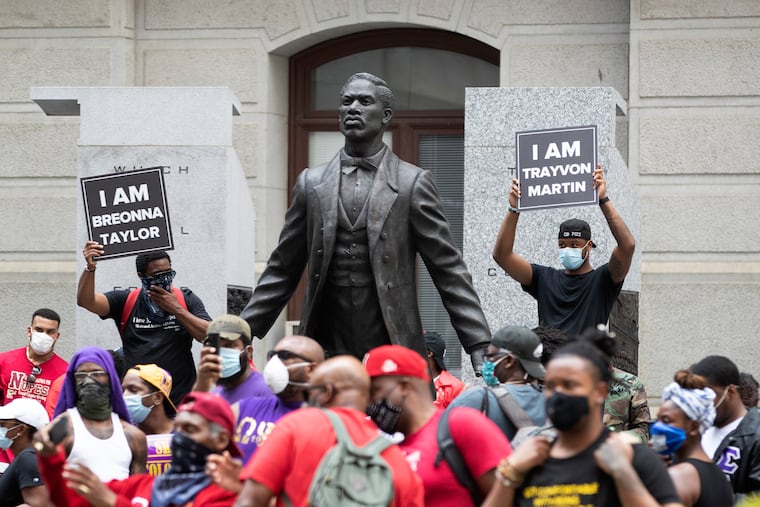Octavius Catto would’ve relished 2020’s call for equality | Opinion
Since police killed George Floyd, Catto’s statue at the southwest corner of City Hall has become a focal point for protests. He gazes over marchers — women and men, all races, young and old, ministers and the mayor.

Now that Frank Rizzo’s statue is gone and Columbus’ is besieged, let’s ponder another Philadelphia statue that’s been in the news: Octavius Valentine Catto, 19th century civil rights advocate.
Since police killed George Floyd, Catto’s statue at the southwest corner of City Hall has become a focal point for protests. He gazes over marchers — women and men, all races, young and old, ministers and the mayor.
Catto looks at home.
» READ MORE: 3 black Philadelphians whose statues should replace Frank Rizzo | Opinion
Sculptor Branly Cadet depicted Catto stepping forward, arms outstretched, as if to welcome allies or challenge foes. He strides toward a polished steel globe — a ballot box, as it looked in 1871.
“There must come a change,” Catto told blacks and whites here in 1864. His words are on the sculpture unveiled in 2017. Even that signaled change: Of some 1,700 statues on public ground in Philadelphia, Catto’s is the first honoring an African American.
So, who was Catto? How might he view the current protests? What did he march for?
He pushed to integrate the Army, literary societies, the Franklin Institute. He challenged baseball’s color line 80 years before Jackie Robinson. He organized streetcar sit-ins 90 years before Rosa Parks; he marched for voting rights a century before Selma.
He was one among “thousands of O.V. Cattos,” as descendant Leonard Smith says — men and women who fought slavery, ran the Underground Railroad, and agitated for justice. They did so in an era when Northern whites periodically rioted against black neighborhoods, burning churches, meeting halls, and schools. Learning while black was unsafe. South Carolina, where Catto was born in 1839, punished black teachers with whippings.
After William T. Catto got his family to Philadelphia in 1848, his son O.V., as friends knew him, soared. A teacher by age 19, he set out to change the world.
» READ MORE: Make Juneteenth a federal holiday | Opinion
That was one of the qualities he and his allies shared with their modern counterparts:
They were young. Catto’s friend Jake White was 18 when he stood up and dared Pennsylvania’s governor to support black rights. Teacher Caroline Le Count was 21 when she flagged down a horse-drawn streetcar — and became the Rosa Parks of Philadelphia.
Women led. They opened schools in the South, sat down in trains or theaters, got ejected or injured, and sued. Ida B. Wells lost her case against a railroad — but went on to expose lynchings.
They networked. Racist “outrages” sparked protests elsewhere, even abroad. Teen activist Charlotte Forten talked tactics with white Boston abolitionist William Lloyd Garrison. (He argued “beautifully” for nonviolence, she wrote, but “I believe in ‘resistance …’ “)
By 1870, after decades’ agitation, the ballot box seemed within reach: The 15th Amendment gave votes to black men. (Women had to fight another half century.) To celebrate, Catto, Frederick Douglass, and thousands of others marched for five miles in Philadelphia streets. Some whites greeted them with stones, garbage, even gunfire. Douglass said he felt the 15th Amendment shielding him like “the hide of a rhinoceros.”
Democrats, then the party of "White Man's Government," began scheming to pierce that hide. Familiar with voter ID laws and the like? You could say that scheme continues.
» READ MORE: ‘Disappearing Blackness’: The campaign to show how African American history in Philly is being erased
In Philadelphia and Camden, white thugs and police who owed their jobs to powerful Democrats attacked black men at the polls. These black men were killed: Jacob Gordon, Levi Bolden, and Isaac Chase, slain in front of his 11-year old daughter.
And Catto. A Democratic operative shot him on Oct. 10, 1871. He died at age 32 with sample ballots in his pocket.
All of which makes his statue a good place to take a knee, or take a stand.
In 1866, Catto said: “We respectfully call upon our liberal-minded and friendly white fellow-citizens to cease to remain silent witnesses.”
He might have relished the modern version: "Silence = violence."
Next Election Day, stop by Catto's statue. Look into the ballot box's polished surface. You'll see your reflection.
Former Inquirer journalist Daniel R. Biddle is the author, with Murray Dubin, of “Tasting Freedom: Octavius Catto and the Battle for Equality in Civil War America.”